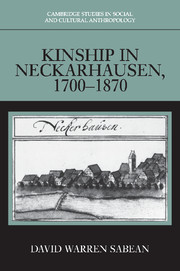Book contents
- Frontmatter
- Contents
- List of tables
- Abbreviations
- Abbreviations of sources
- On reading kinship diagrams
- Glossary
- Preface
- Introduction
- Cohort I (1700–1709)
- 4 Introduction to kinship during the early decades of the eighteenth century
- 5 Kinship as a factor in marriage strategy
- 6 Marriage and kinship practices
- 7 Ritual kinship
- 8 Naming children
- Cohort II (1740–1749)
- Cohort III (1780–1789)
- Cohort IV (1820–1829)
- Cohort V (1860–1869)
- Conclusion
- Appendix
- Bibliography
- General index
- Index of villagers
6 - Marriage and kinship practices
Published online by Cambridge University Press: 04 August 2010
- Frontmatter
- Contents
- List of tables
- Abbreviations
- Abbreviations of sources
- On reading kinship diagrams
- Glossary
- Preface
- Introduction
- Cohort I (1700–1709)
- 4 Introduction to kinship during the early decades of the eighteenth century
- 5 Kinship as a factor in marriage strategy
- 6 Marriage and kinship practices
- 7 Ritual kinship
- 8 Naming children
- Cohort II (1740–1749)
- Cohort III (1780–1789)
- Cohort IV (1820–1829)
- Cohort V (1860–1869)
- Conclusion
- Appendix
- Bibliography
- General index
- Index of villagers
Summary
Chapter 5 explored the regularities of kin-linked marital unions taken in turn and the implications of recurrent forms for all the individuals linked together in chains that closed back in on themselves. But how are these sets of people, who are asymmetrically connected to one another, interlocked with other such sets? And how did the construction of affinal clusters grow out of the relationships originally established among siblings? These are the subjects of this chapter.
As mentioned earlier, many marriages in Neckarhausen involved strategies aimed at maximizing both the strength of kinship ties and their number. Pursuing both objectives at once led to a typical pattern of reinforcing and redoubling ties between three, four, or five households. But the way new affinal connections could be joined to existing alliances at any “angle,” so to speak, suggests that these networks were open ended and flexible enough to react to family crises and shifting political and productive situations. Kinship was not a closed principle, even though it had a systemic quality to it and could act as an organizing mechanism for partisan political groups and village factions of various kinds.
Despite the open-endedness of kinship networks or perhaps because of it, people sought closure from time to time. In the flow of exchange, the institution of marriage and that of godparentage created long-term structures and continuous fault lines, providing regularity, dependability, and concentrated attention.
- Type
- Chapter
- Information
- Kinship in Neckarhausen, 1700–1870 , pp. 127 - 141Publisher: Cambridge University PressPrint publication year: 1997



